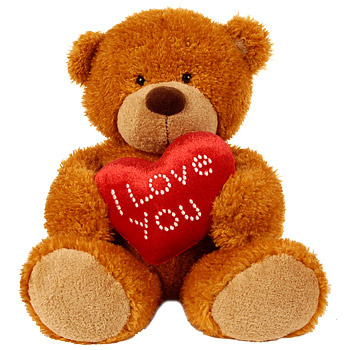 For most of human history, wild animals presented a very real threat to people. They lived among nature but had very little control over it. For a large bear to come to your house asking for your daughter in marriage is somewhat like, today, say, a terrorist showing up at your door.
For most of human history, wild animals presented a very real threat to people. They lived among nature but had very little control over it. For a large bear to come to your house asking for your daughter in marriage is somewhat like, today, say, a terrorist showing up at your door.Then, as humans built up cities and became more developed, they also started to show more control over animals. Bears were trained to dance for entertainment:
 Image of Dancing Bear from here
Image of Dancing Bear from hereThen bears were turned into cute, cuddly toys. Bears and other wild animals are no longer threatening, but like fairy tales in general, became something fit for children. The only time most children nowdays see real wild animals are in a zoo. As nature becomes less and less in our daily lives, it's also some kind of lost ideal to us-this mysterious and wonderful part of our past we want to get back to. Therefore the modern reader tends to see a Beast as exciting and mysterious.
 The fact that this picture is "Beauty in the Beast" almost makes me angry. This isn't an image of Beauty and the Beast at all-this is "Little girl having a tea party with her Curious George doll."
The fact that this picture is "Beauty in the Beast" almost makes me angry. This isn't an image of Beauty and the Beast at all-this is "Little girl having a tea party with her Curious George doll."The above picture detracts from the fact that the story is also a sensual story-one about a girl being romantically and sexually pursued by an animal. The story that goes with the picture is about a little girl and her dolls-it should hardly share the same name as the fairy tale. Some people connect Beauty and the Beast with beastiality, but there's a difference between an animal, and a person that talks and has a mind but is in the form of an animal. Since we are in the realm of fairy tales, where transformations between animals and people are not uncommon, the reader isn't that surprised when the Beast turns into a man. However, the Beast undoubtably represents an overexaggerated male figure. He's male, but usually larger than a normal person, and with the animal instincts of the form he's taken. During times of arranged marriages where women had no control over their spouses and were married off at young ages, a future groom would undoubtably seem to them more like a Beast or a monster than a handsome prince.
I think it's safe to say the Disney's Beast is one of the more attractive, human-like Beasts out there.
 Other artists have portrayed the Beast as various animals:
Other artists have portrayed the Beast as various animals: Eleanor Vere Boyle
Eleanor Vere Boyle Anonymous illustrator-for Charles Lamb's poem "Beauty and the Beast"
Anonymous illustrator-for Charles Lamb's poem "Beauty and the Beast"For more pictures of Beauty and the Beast, visit here.
Though as far as I know, no one has tried to illustrate Villeneuve's Beast, who had scales that clanked, as well as "a trunk resembling an elephant's."
As our culture is gradually encouraging men and women alike to embrace and celebrate their sexuality, rather than the Victorian sensibility of pretending it didn't exist, or the childrenized version of a stuffed animal, the Beast in his natural state becomes more and more celebrated. Modern versions often don't end with transformation. Francesca Lia Block's Beauty becomes more and more like the Beast herself.
 This is going back to the "animals are cute" ideal. Here's my plush Beast, chillin' on my bed with my Belle pillowcase.
This is going back to the "animals are cute" ideal. Here's my plush Beast, chillin' on my bed with my Belle pillowcase.

No comments:
Post a Comment